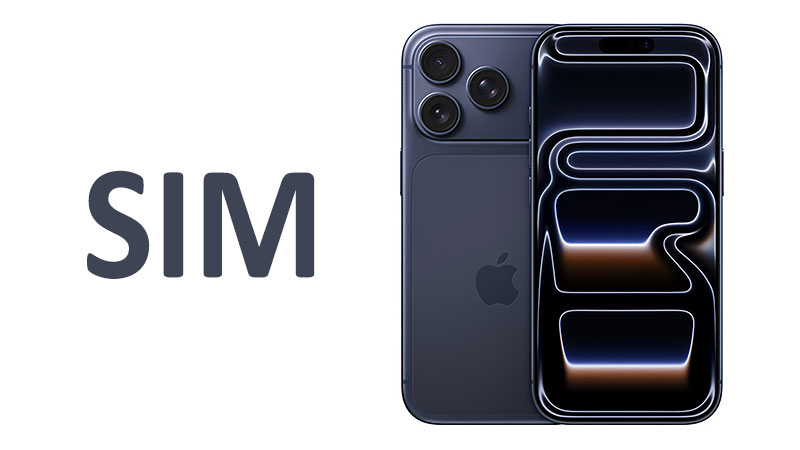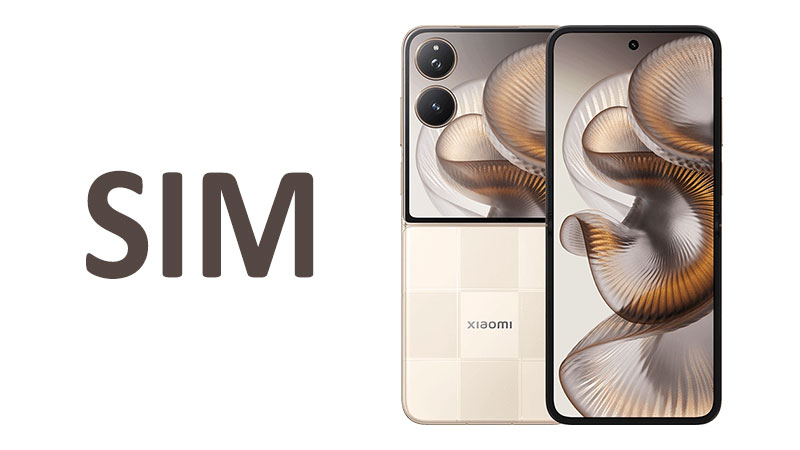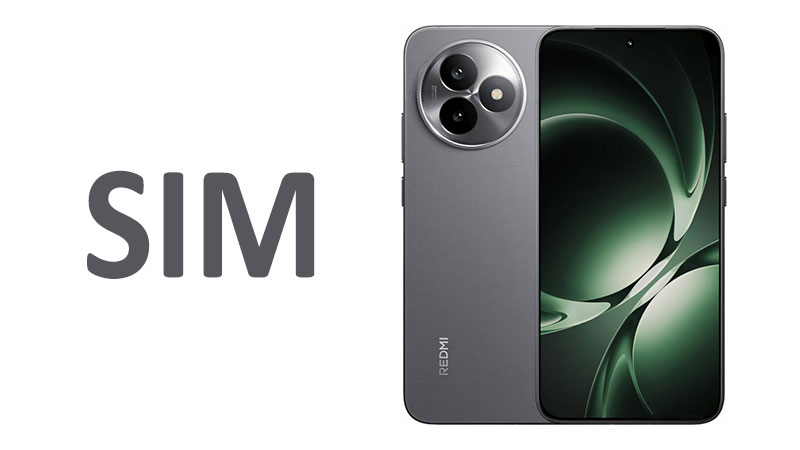The Apple iPhone 17 Pro SIM management and its advanced connectivity suite represent a significant leap forward in mobile technology. This flagship device combines flexible digital and physical identity options with cutting-edge network speed. Professionals and enthusiasts require a seamless, high-performance experience. Understanding the specifics of its eSIM, Dual-SIM configuration, and powerful wireless standards is essential. This article provides a comprehensive, deep dive into every aspect of the iPhone 17 Pro’s connectivity profile. It helps potential owners appreciate the value of this premium communication device.
The Pro-Level Standard: SIM Architecture and Global Identity
The iPhone 17 Pro reinforces Apple’s commitment to modernization in managing cellular service. Its Subscriber Identity Module (SIM) architecture prioritizes the security and flexibility of the digital eSIM. This design allows for different configurations worldwide. It intelligently addresses both convenience and regulatory compliance across diverse markets.
Customized Regional SIM Configurations
The available SIM setup is meticulously tailored to the specific country of purchase. This is a crucial distinction for international buyers and frequent travelers. Apple optimizes the hardware to best integrate with regional carrier ecosystems.
International Model: Physical and Digital Flexibility
The version of the iPhone 17 Pro sold in most international markets offers maximum adaptability. It supports one physical Nano-SIM card. Additionally, it can store multiple eSIM profiles digitally. The device is designed to run a maximum of two lines actively at any time. This powerful feature is known as Dual-SIM support. Users can utilize the physical Nano-SIM alongside one active eSIM. Alternatively, they can operate two active eSIM profiles concurrently. This versatility perfectly serves users needing separate lines for work and personal communication. It also streamlines global travel by managing home and international prepaid data plans effortlessly.
USA Model: Fully Digital eSIM Integration
In the United States, the iPhone 17 Pro is engineered exclusively for the eSIM standard. This US model contains no physical SIM card tray in its hardware. Users can store eight or more eSIM profiles on the device. However, only two of these profiles can be active simultaneously for Dual-SIM use. This shift to eSIM-only provides distinct advantages. It enhances the phone’s resistance to environmental factors like water and dust. It also strengthens security against unauthorized physical tampering. The digital-only approach reflects the direction of advanced mobile network technology.
China Model: Dual Physical SIM Requirement
To comply with unique regulations and strong consumer preference in mainland China, a specific hardware variant exists. The iPhone 17 Pro model sold in China includes a tray that accommodates two physical Nano-SIM cards. This enables dedicated dual physical SIM functionality. The eSIM capability is often unavailable or disabled in this regional version. This ensures the Pro model remains compliant and functional in the largest Asian market.
Specialized Comparison: Pro SIM vs. Predecessors
The iPhone 17 Pro continues the eSIM-centric design. This setup was standardized by the iPhone 15 series in the US market. Compared to older iPhones that featured a physical SIM slot globally, the 17 Pro offers superior digital line management.
The eSIM proves far more flexible than a traditional Nano-SIM. Activating a new eSIM plan is nearly instantaneous via a quick digital download. Conversely, a physical SIM requires manual handling and shipment. The iPhone 17 Pro can store numerous eSIM profiles. This dramatically simplifies switching carriers for both domestic and international users. This convenience is a key selling point for the Pro user base. Furthermore, the embedded nature of the eSIM inherently improves security. It cannot be lost or easily swapped out by thieves.
Pros and Cons of the eSIM-Focused Architecture
The premium focus on the embedded SIM in the iPhone 17 Pro brings clear advantages for the demanding user. However, this modern approach still presents a few limitations that buyers must be aware of.
Pros of eSIM Technology
- Enhanced Security Features: The eSIM is permanently housed within the device. This prevents physical removal in cases of loss or theft. It greatly supports the effectiveness of the phone’s location and anti-theft tracking.
- Perfect Dual-SIM Management: Professionals can seamlessly maintain two distinct phone numbers on one device. This efficiently separates business and personal life.
- Fast and Simple Activation: Activating a new service plan or international travel plan is quick and entirely digital. This eliminates the wait time for physical card delivery.
- Increased Durability: Removing the physical SIM tray minimizes potential points of entry. This contributes to better dust and water resistance ratings.
- Optimized Internal Design: Eliminating the bulky SIM tray mechanism frees up internal space. Engineers can then dedicate this space to other critical components, such as camera stabilization.
Cons of eSIM Technology
- Carrier Migration Difficulty: Transferring an existing eSIM profile to a new device can be complicated. This process often requires direct communication or support from the mobile network carrier.
- Inconsistent Global Support: While adoption is accelerating, eSIM technology is not yet supported by all smaller, regional international carriers. Travelers might encounter limitations in developing markets.
- Complex Troubleshooting: Diagnosing a network issue is easier with a physical SIM. Users can simply swap cards. Troubleshooting an eSIM fault often demands more complex digital steps and carrier assistance.
Important Points for Pro Buyers Regarding SIM
Buyers must prioritize the device’s origin when purchasing the iPhone 17 Pro. The US model is strictly eSIM-only. Global travelers who rely on readily available, inexpensive foreign physical SIM cards must confirm destination carrier eSIM support. Power users should actively leverage the robust Dual-SIM capability. It allows for advanced line management and cost optimization while traveling. Storing multiple international data plans ensures instantaneous connectivity upon arrival anywhere.
Unmatched Wireless Performance: Cellular and Wi-Fi Standards
The iPhone 17 Pro is equipped with a comprehensive suite of wireless technologies. It ensures reliable access across all major cellular generations. More importantly, it features the very latest standards for peak performance.
Comprehensive Cellular Network Support
The iPhone 17 Pro supports an extensive array of cellular communication protocols. These include GSM, CDMA, HSPA, EVDO, and LTE. This wide-ranging support guarantees essential backward compatibility. The phone can connect to a network virtually anywhere in the world. However, the core of its performance lies in the advanced 5G capabilities.
The 5G technology delivers significantly faster data download and upload speeds. Crucially, it provides dramatically reduced network latency. Low latency is vital for professional and competitive mobile activities. These include cloud rendering, real-time collaboration, and intensive online gaming. The Pro model is specifically engineered to harness all facets of the 5G spectrum. It includes both widespread Sub-6GHz and the high-speed mmWave bands.
Specialized Comparison: 5G Pro Modem
The 5G modem and antenna array in the iPhone 17 Pro are best-in-class. They offer superior speed and efficiency compared to standard models and most competitors. The Pro model’s distinct advantage is its seamless access to mmWave 5G. This technology offers multi-gigabit speeds. However, it is only available over short distances in dense urban areas.
Compared to the standard iPhone 17, the Pro model’s inclusion of all 5G bands offers a performance ceiling. This ceiling is unmatched when the user is within range of mmWave towers. The advanced modem design also provides better energy efficiency. This ensures the phone maintains high speeds while optimizing battery life during prolonged data use. This is crucial for professional users constantly demanding peak cellular performance.
Next-Gen Wi-Fi: Wi−Fi7 and 6E Tri-Band
The iPhone 17 Pro features the most advanced wireless networking suite available. It supports both Wi−Fi6E (802.11ax) and the revolutionary Wi−Fi7 (802.11be) standards. This combination ensures maximum compatibility and future-proof speed.
Wi−Fi7 is the most important feature here. It introduces Multi-Link Operation (MLO). MLO allows the phone to simultaneously use multiple frequency bands. The Pro supports tri-band operation: 2.4 GHz, 5 GHz, and 6 GHz. This simultaneous use drastically reduces latency and boosts data throughput to multi-gigabit levels. Wi−Fi7 is perfect for massive data transfers and low-latency cloud workflows.
The inclusion of Wi−Fi6E is also significant. Wi−Fi6E uses the 6 GHz band. This band is less congested than the older 2.4 GHz and 5 GHz bands. This provides a “cleaner” wireless connection and higher sustained speeds. It works seamlessly even when a full Wi−Fi7 network is unavailable.
Pros and Cons of Wi-Fi 7 Adoption
The primary advantage is theoretical and realized speed. Wi−Fi7 can provide speeds faster than wired Gigabit Ethernet connections. It offers unmatched performance in dense environments with many competing wireless devices. The main limitation is the current availability of Wi−Fi7 routers. Users must invest in new home networking equipment to fully exploit this feature. However, the Wi−Fi6E fallback provides an immediate, substantial speed upgrade over previous Wi-Fi generations.
Buyer Guidance on Wireless Performance
Buyers should see the iPhone 17 Pro as a device built for demanding wireless tasks. The combination of comprehensive 5G and Tri-band Wi−Fi7 guarantees top-tier performance. Professionals who frequently upload large files or rely on stable connections will notice the difference. The Wi−Fi6E capability offers an immediate performance boost over standard Wi−Fi6 phones. This is true even if a Wi−Fi7 router is not yet in place.
High-Precision Positioning and Navigation
The iPhone 17 Pro features a state-of-the-art location service system. This guarantees exceptional accuracy and reliability for all location-based applications.
Dual-Frequency GPS: L1 and L5
The iPhone 17 Pro utilizes dual-frequency GPS support. This includes the standard civilian L1 signal and the modern, high-integrity L5 signal. The L5 signal is specifically designed to combat common location errors. These errors include signal reflection off tall buildings.
By processing both L1 and L5 signals, the iPhone 17 Pro achieves vastly improved location accuracy. This is critical for reliable navigation in challenging urban environments. Users will experience precise, stable location tracking. This makes navigating complex city streets far more dependable.
The phone connects to a comprehensive network of global satellite navigation systems. These include GPS, GLONASS (Russia), GALILEO (Europe), BDS (China), QZSS (Japan), and NavIC (India). This extensive multi-system support ensures immediate and accurate location fixes worldwide. The inclusion of NavIC significantly enhances regional accuracy in the Indian subcontinent.
Specialized Comparison: Dual-Frequency vs. Single-Frequency GPS
The primary difference between the Pro and standard models is the dual-frequency GPS. The standard iPhone 17 uses only the single L1 frequency. The iPhone 17 Pro’s dual (L1+L5) system offers superior resistance to multipath interference. This means the Pro model is noticeably more accurate in urban canyons and heavily forested areas. For serious hikers, geocachers, or ride-share drivers, this precision is worth the premium. It translates directly into more reliable direction reporting.
Buyer Guidance on Positioning
The iPhone 17 Pro provides professional-grade location accuracy. Users relying on precision for surveying, detailed mapping, or high-level fitness tracking will benefit most. The robust, multi-system support ensures dependable positioning globally. This feature elevates the Pro model above standard consumer devices. The enhanced safety features also benefit from this superior location accuracy during emergency situations.
Advanced Short-Range and Wired Connectivity
The iPhone 17 Pro optimizes short-range wireless communication and provides a massive upgrade to wired data transfer. These features are tailored for high-speed professional workflows.
Bluetooth 6.0: Efficiency and Throughput
The iPhone 17 Pro features the latest Bluetooth 6.0 standard. This is a noticeable improvement in stability, range, and power consumption. Bluetooth 6.0 is highly optimized for low-energy (LE) operations. This results in significantly longer battery life for connected accessories like wireless earbuds and smartwatches.
The 6.0 standard also provides faster data rates and improved handling of multiple connections. This ensures high-quality audio streaming. It also improves seamless communication with complex smart home or vehicle systems. The A2DP and LE support combine high-fidelity sound with minimal energy draw.
Comparison: Bluetooth 6.0 vs. 5.3
Bluetooth 6.0 offers incremental but important efficiency gains over the older 5.3 standard. The spectral utilization is better, meaning connections are more robust in congested environments. The improved LE performance is key. It allows accessories to stay connected longer without draining the phone or the accessory battery. This is an essential evolution for the wireless accessory ecosystem.
NFC for Contactless Transactions
Near Field Communication (NFC) is fully integrated into the Pro model. This technology is vital for secure, instant, contactless payments via Apple Pay. It also supports quick device pairing and streamlined data exchange with compatible hardware. NFC remains a cornerstone for day-to-day utility, from transit passes to digital keys.
Wired Connectivity: USB Type-C 3.2 Gen 2 and DisplayPort
The iPhone 17 Pro features a USB Type-C port. Crucially, it supports the USB 3.2 Gen 2 standard. This is the single biggest performance upgrade for content creators.
USB 3.2 Gen 2 offers a maximum theoretical data transfer speed of 10 Gigabits per second (Gbps). This speed is approximately 20 times faster than the 480 Mbps limit of the older USB 2.0 standard. Transferring massive video files, like 4K ProRes clips, becomes nearly instantaneous. This saves professional users hours of waiting time over a year of heavy use.
The port also includes full DisplayPort functionality. This allows the iPhone 17 Pro to output high-resolution video directly to an external monitor or display. Users can mirror their screen or use the external monitor as an extended desktop. This transforms the phone into a true mobile workstation.
Specialized Comparison: USB 3.2 Gen 2 vs. USB 2.0
The standard iPhone 17 uses the slower USB 2.0 standard. This makes the USB 3.2 Gen 2 port a major differentiator for the iPhone 17 Pro. The speed gap is enormous. It directly separates the casual consumer from the power user. For photographers, videographers, and developers, this high-speed port alone justifies the Pro purchase. It ensures seamless integration with desktop workflows. This superior wired performance is a defining characteristic of the Pro series.
Buyer Guidance on USB-C Performance
Buyers must understand the USB 3.2 Gen 2 is designed for speed. Use high-quality USB−C cables rated for 10 Gbps to realize this potential. Content professionals should leverage this speed for direct backups and tethered shooting. The DisplayPort feature simplifies presentations and external editing setups. This wired capability cements the iPhone 17 Pro’s role as a mobile powerhouse.
Global Connectivity Ecosystem and Reliability
The overall connectivity package of the iPhone 17 Pro is engineered for maximum reliability and global utility. It combines various technologies into a cohesive, high-performance ecosystem.
Integrated Modem and Antenna Design
Apple customizes the integration of its cellular modem and antenna arrays. This approach often leads to superior signal strength and more reliable network hand-offs. The iPhone 17 Pro maintains a consistent connection. This is true even when users move between Sub-6GHz and mmWave 5G zones. This reliability is paramount for professional communications.
The Omission of FM Radio
Like all modern flagship smartphones, the iPhone 17 Pro does not include a dedicated FM radio tuner. Users access all radio content via internet streaming applications. This streaming relies on the phone’s exceptional Wi−Fi7 or 5G connectivity. This design choice reflects the consumer shift toward digital media consumption.
Overall Connectivity Review
The iPhone 17 Pro offers a comprehensive and robust connectivity profile. The regional SIM flexibility caters to the global market perfectly. The inclusion of Wi−Fi7 and Bluetooth6.0 ensures best-in-class wireless performance. The dual-frequency GPS delivers professional-grade accuracy. Most significantly, the USB 3.2 Gen 2 with DisplayPort is a game-changer. It eliminates the bottleneck of slow wired data transfer. This makes the iPhone 17 Pro an essential tool for high-demand users.
Conclusion: The Definitive Connectivity Choice
The Apple iPhone 17 Pro SIM and connectivity features clearly position it as a premium device. Its sophisticated eSIM architecture offers unparalleled security and flexibility. The eSIM-only variant in the USA is a testament to Apple’s vision for a digital future. Dual-SIM support remains vital for global mobile management.
The wireless technologies are top-of-the-line. Full 5G band support, including mmWave, provides maximum mobile speed. The combination of Wi−Fi6E and Wi−Fi7 ensures multi-gigabit speeds on local networks. For accuracy, the dual-frequency GPS is a critical upgrade over standard phones. Ultimately, the USB 3.2 Gen 2 port provides the necessary wired speed for professional workflows. If cutting-edge speed, maximum flexibility, and zero data bottlenecks are essential, the iPhone 17 Pro is the superior connectivity choice.
Frequently Asked Questions (FAQ)
- Does the iPhone 17 Pro support the fastest wired data transfer speed? Yes, the iPhone 17 Pro features USB 3.2 Gen 2. This supports speeds up to 10 Gbps.
- Does the iPhone 17 Pro work on the newest Wi−Fi7 networks? Yes, the device is Wi−Fi7 compatible. It also supports the highly efficient tri-band Wi−Fi6E.
- Can the iPhone 17 Pro show its screen on an external monitor? Yes, the USB Type-C port includes DisplayPort functionality. This allows for direct, high-resolution video output.
- Is the positioning on the iPhone 17 Pro more accurate than older models? Yes, it uses dual-frequency GPS (L1+L5). This provides superior accuracy, especially in urban areas with tall buildings.
- Can I use a Nano-SIM and two eSIM profiles simultaneously on the Pro model? No, the device allows for storing many eSIM profiles. However, it only supports a maximum of two active lines at any given time.



